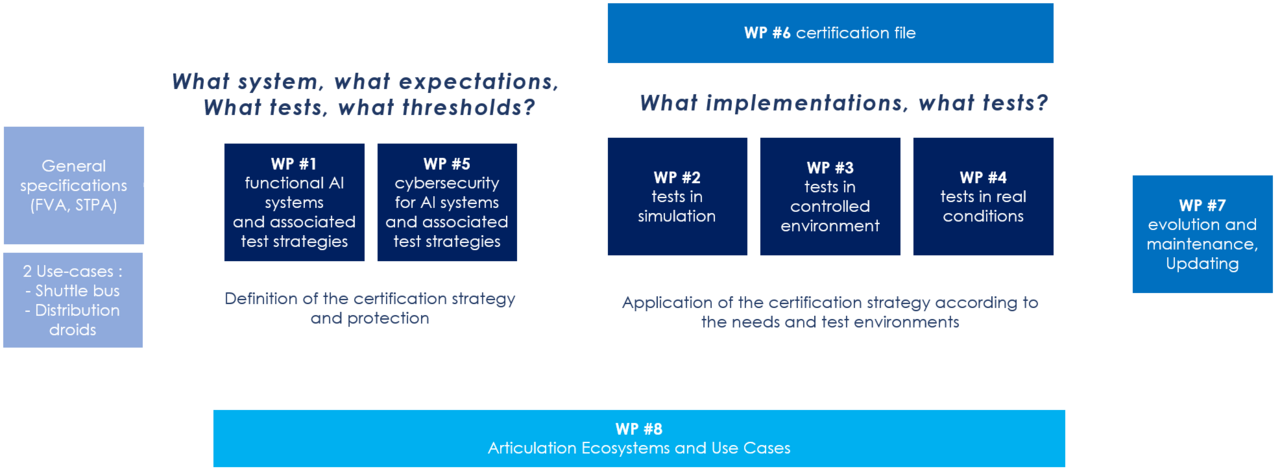The PRISSMA project is articulated in eight working groups, with complementary objectives.
WP#1 :
- Estimate the level of criticality of each AI-based system function in relation to its function and use domain.
- Express demonstrable requirements applicable to AI-based functions and evaluation criteria.
- Deduce requirements for the means of testing and auditing to be put in place (supports and methods).
WP#2 :
- Define qualification processes for simulation tools (Software, Simulator, Hybrid...) to ensure interoperability and representativeness of simulation results, and thus make them acceptable in a certification process.
- Define and automate test plans (creation of relevant scenarios including coverage measurement, verifiable expected behavior and analyses of simulation results), with identification of the optimal scope (including dysfunctional through fault injection...) for AI-based systems.
- Define a generic and scalable environment hosting interoperable simulation tools with a view to national and international recommendations.
- Realize a prototype instantiation for an application to proofs of concepts demonstrating the achievement of the expected results.
WP#3 :
- Practical implementation of the qualification processes of the testing facilities in a controlled environment.
- Practical implementation of test plans in addition to simulation, with identification of the optimum perimeter of the system of systems, i.e. vehicle, infrastructure and supervision. This implementation also includes the dysfunctional through the injection of failures.
- Specification of the necessary testing facilities (infrastructure, equipment, supervision systems, personnel) and their qualification, in a national or European perspective.
WP#4 :
- Propose test scenarios, methodologies and associated intervention procedures for real-life tests of autonomous mobility systems in addition to the previous tests.
WP#5 :
- Propose a cybersecurity vision of the AI-centric conceptual approach and its specific requirements, in order to formalize a transverse cybersecurity scheme, bounded by a perimeter encompassing AI-based systems and addressing both cybersecurity threats and objectives to counter them.
- Address the connectivity issues required in secure autonomous ecosystems through the identification of performance and interoperability issues required for AI-based functions in a system of systems framework.
- Analyze the problem of verification of reliability (verification of functionalities) and cybersecurity of secure autonomous ecosystems through the characterization (and, if necessary: the implementation of tests) of a set of dedicated tools.
WP#6 :
- Integrate in the pre-existing standards of recommendations and good practices the specificities related to AI in order to define the actions that will complete the possible demonstrations by tests.
- Propose the type of proofs that will be provided under the responsibility of the industrialists in charge of the developments, some of these proofs being able to contribute significantly to the homologation activities according to the level of maturity implemented and demonstrated by the industrialists.
WP#7 :
- Take into account the specificities related to AI in the maintenance process by detecting performance evolutions in relation to the requirements.
- Identify situations that do not meet requirements and propose a feedback process to methodologies, tools and platforms for certification.
WP#8 :
- Manage the articulation (regulatory and technical), national and international, of the PRISSMA project with the whole ecosystem of autonomous mobility, by guaranteeing the alignment with the national strategy and the expectations of the authorities and the industry.
- Address the constraints related to the efficiency of the process in relation to the evolutions that will occur on the functions and systems, to guarantee the relevance of the economic model in relation to the regulatory constraints and the needs of the authorities.
- Take into account the aspects related to the global perimeter of autonomous mobility by guaranteeing the compatibility of the systems or functions integrating AI and their interfaces with all the elements composing this perimeter.
- Consolidate the method and tools necessary to characterize and enrich the ODDs, based on the state of the art and on a methodology for decomposing routes and assessing their criticality.

